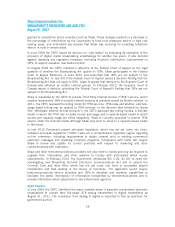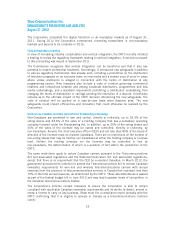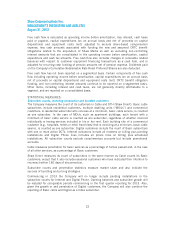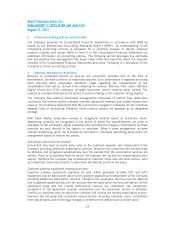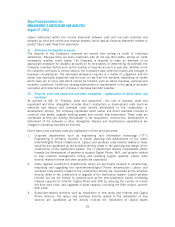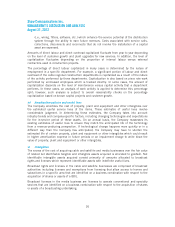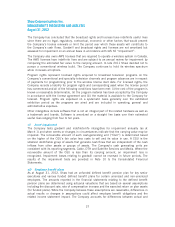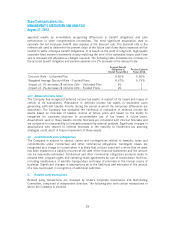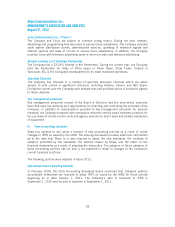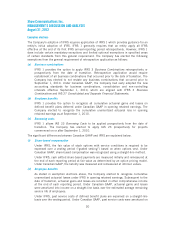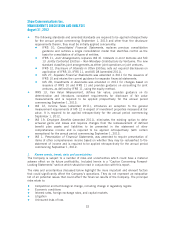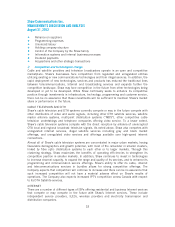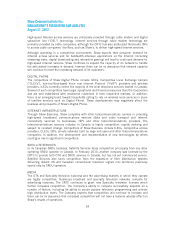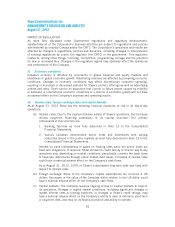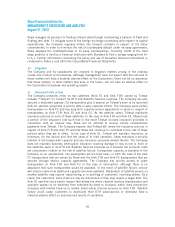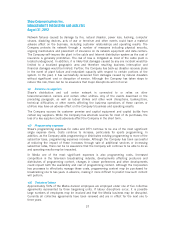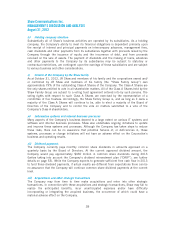Shaw 2012 Annual Report Download - page 32
Download and view the complete annual report
Please find page 32 of the 2012 Shaw annual report below. You can navigate through the pages in the report by either clicking on the pages listed below, or by using the keyword search tool below to find specific information within the annual report.
Shaw Communications Inc.
MANAGEMENT’S DISCUSSION AND ANALYSIS
August 31, 2012
assumed results by immediately recognizing differences in benefit obligations and plan
performance in other comprehensive income/loss. The most significant assumption used to
calculate the net employee benefit plan expense is the discount rate. The discount rate is the
interest rate used to determine the present value of the future cash flows that is expected will be
needed to settle employee benefit obligations. It is based on the yield of long-term, high-quality
corporate fixed income investments closely matching the term of the estimated future cash flows
and is reviewed and adjusted as changes required. The following table illustrates the increase on
the accrued benefit obligation and pension expense of a 1% decrease in the discount rate:
Accrued Benefit
Obligation at
End of Fiscal 2012
Pension Expense
Fiscal 2012
Discount Rate – Unfunded Plan 4.50% 5.50%
Weighted Average Discount Rate – Funded Plans 4.67% 5.75%
Impact of: 1% decrease ($ millions Cdn) – Unfunded Plan 65 1
Impact of: 1% decrease ($ millions Cdn) – Funded Plans 26 1
viii) Deferred income taxes
The Company has recognized deferred income tax assets in respect of its losses and losses of
certain of its subsidiaries. Realization of deferred income tax assets is dependent upon
generating sufficient taxable income during the period in which the temporary differences are
deductible. The Company has evaluated the likelihood of realization of deferred income tax
assets based on forecasts of taxable income of future years and based on the ability to
reorganize its corporate structure to accommodate use of tax losses in future years.
Assumptions used in these taxable income forecasts are consistent with internal forecasts and
are compared for reasonability to forecasts prepared by external analysts. Significant changes in
assumptions with respect to internal forecasts or the inability to implement tax planning
strategies could result in future impairment of these assets.
ix) Commitments and contingencies
The Company is subject to various claims and contingencies related to lawsuits, taxes and
commitments under contractual and other commercial obligations. Contingent losses are
recognized by a charge to income when it is likely that a future event will confirm that an asset
has been impaired or a liability incurred at the date of the financial statements and the amount
can be reasonably estimated. Contractual and other commercial obligations primarily relate to
network fees, program rights and operating lease agreements for use of transmission facilities,
including maintenance of satellite transponders and lease of premises in the normal course of
business. Significant changes in assumptions as to the likelihood and estimates of the amount
of a loss could result in recognition of additional liabilities.
G. Related party transactions
Related party transactions are reviewed by Shaw’s Corporate Governance and Nominating
Committee, comprised of independent directors. The following sets forth certain transactions in
which the Company is involved.
28


